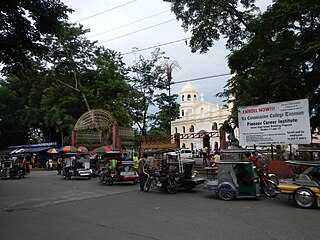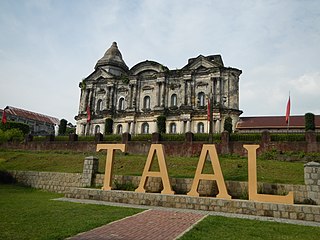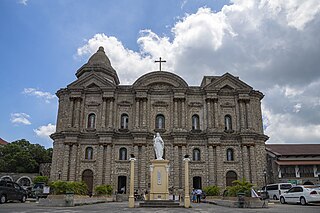
Batangas, officially the Province of Batangas, is a first class province of the Philippines located in the southwestern part of Luzon in the Calabarzon region. Its capital is the city of Batangas, and is bordered by the provinces of Cavite and Laguna to the north, and Quezon to the east. Across the Verde Island Passages to the south is the island of Mindoro and to the west lies the South China Sea. Poetically, Batangas is often referred to by its ancient name, Kumintáng.

Tagaytay, officially the City of Tagaytay, is a 2nd class component city in the province of Cavite, Philippines. According to the 2020 census, it has a population of 85,330 people.

Lipa, officially the City of Lipa, is a 1st class component city in the province of Batangas, Philippines. According to the 2020 census, it has a population of 372,931 people.

Taal Volcano is a large caldera filled by Taal Lake in the Philippines. Located in the province of Batangas about 50 kilometers (31 mi) south of Manila, the volcano is the second most active volcano in the country with 38 recorded historical eruptions, all of which were concentrated on Volcano Island, near the middle of Taal Lake. The caldera was formed by prehistoric eruptions between 140,000 and 5,380 BP.

Taal Lake, formerly known as Bombón Lake, is a freshwater caldera lake in the province of Batangas, on the island of Luzon in the Philippines. The lake fills Taal Volcano, a large volcanic caldera formed by very large eruptions between 500,000 and 100,000 years ago.

Talisay, officially the Municipality of Talisay, is a 3rd class municipality in the province of Batangas, Philippines. According to the 2020 census, it has a population of 46,238 people.

Tanauan, officially the City of Tanauan, is a 1st class component city in the province of Batangas, Philippines. According to the 2020 census, it has a population of 193,936 people.

Bauan, officially the Municipality of Bauan, is a 1st class municipality in the province of Batangas, Philippines. According to the 2020 census, it has a population of 90,819 people.

Laurel, officially the Municipality of Laurel, is a 3rd class municipality in the province of Batangas, Philippines. According to the 2020 census, it has a population of 43,210 people.

San Nicolas, officially the Municipality of San Nicolas, is a 5th class municipality in the province of Batangas, Philippines. According to the 2020 census, it has a population of 23,908 people. It is equivalent to 0.15% of the population in the Calabarzon area or 0.82% of the total population of Batangas province. These numbers are used to calculate the population density, which is 1,057 inhabitants per square kilometer or 2,740 inhabitants per square mile. The municipality makes up 0.73% of Batangas's total area, with a land area of 22.61 square kilometers or 8.73 square miles.

Taal, officially the Municipality of Taal, is a 3rd class municipality in the province of Batangas, Philippines. According to the 2020 census, it has a population of 61,460 people.

The Pansipit River is a short river located in the Batangas province of the Philippines. The river is the sole drainage outlet of Taal Lake, which empties to Balayan Bay. The river stretches some 9 kilometers (5.6 mi) passing along the municipalities of Agoncillo, Lemery, San Nicolas, and Taal, serving as a boundary between the communities. It has a very narrow entrance from Taal Lake.

The Minor Basilica of Saint Martin of Tours, also known as the Taal Basilica, is a minor basilica in the town of Taal, Batangas, within the Archdiocese of Lipa. It is considered to be the largest church in the Philippines and in Asia, standing 88.6 meters (291 ft) long and 48 meters (157 ft) wide. Martin of Tours is the patron saint of Taal, whose feast is celebrated every November 11.

Our Lady of Caysasay is a Roman Catholic image of the Blessed Virgin Mary venerated at the Archdiocesan Shrine of Our Lady of Caysasay in Taal, Batangas, Philippines. The image depicts the Immaculate Conception is believed to be one of the oldest in the country, originally discovered in 1603 by a native man fishing in the Pansipit River. The subsequent Marian apparitions documented by Spanish colonial church leaders were the first in the country; devotees today continue to attribute miracles to the Virgin.
The 1880 Southern Luzon earthquakes, were one of the most destructive tremors on record in the history of the country. The shocks continued, with greater or less interruption, from July 14–25, 1880; highlighted by three violent quakes measuring 7.0, Mw 7.6, and Mw 7.2 respectively. The sequence destroyed churches and other buildings, producing loss of life. Coinciding with the tectonic activity was an increase in volcanic activity in the Taal Volcano of southwestern Luzon.

The Metropolitan Cathedral of San Sebastian, commonly known as the Lipa Cathedral, is a Neo-Renaissance cathedral in Lipa, Batangas, Philippines. The cathedral serves as the seat of the Archdiocese of Lipa. The cathedral was chosen as the seat of the then Diocese of the Lipa in 1910. Detached from the Archdiocese of Manila and canonically erected by Pope Pius X, it comprised what are today the provinces of Batangas, Quezon, Aurora, Laguna, Marinduque, Occidental Mindoro, Oriental Mindoro, and part of the Camarines area.

The 2017 Batangas earthquakes were an earthquake swarm that occurred from early April to mid-August 2017, affecting the province of Batangas in the Philippines and other nearby areas.

The archaeology of the Philippines is the study of past societies in the territory of the modern Republic of the Philippines, an island country in Southeast Asia, through material culture.

Taal Volcano in Batangas, Philippines began to erupt on January 12, 2020, when a phreatomagmatic eruption from its main crater spewed ashes over Calabarzon, Metro Manila, and some parts of Central Luzon and Ilocos Region, resulting in the suspension of school classes, work schedules, and flights in the area. The Philippine Institute of Volcanology and Seismology (PHIVOLCS) subsequently issued an Alert Level 4, indicating "that a hazardous explosive eruption is possible within hours to days." Volcanic activity continued into 2021, when smaller eruptions occurred in July 2021. On 26 March 2022, a short-lived phreatomagmatic eruption was recorded by PHIVOLCS raising the status from Alert level 2 to Alert level 3 as well as surrounding towns.

Batangas's 3rd congressional district is one of the six congressional districts of the Philippines in the province of Batangas. It has been represented in the House of Representatives of the Philippines since 1916 and earlier in the Philippine Assembly from 1907 to 1916. The district consists of the northern Batangas cities of Santo Tomas and Tanauan, as well as adjacent municipalities surrounding the Taal Lake: Agoncillo, Alitagtag, Balete, Cuenca, Laurel, Malvar, Mataasnakahoy, San Nicolas, Santa Teresita and Talisay, a configuration that has been in place since 1987. It is currently represented in the 19th Congress by Ma. Theresa V. Collantes of the Nationalist People's Coalition (NPC).




















